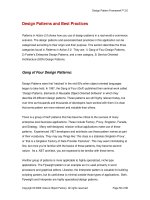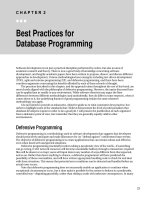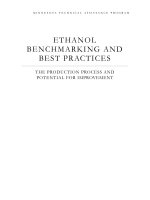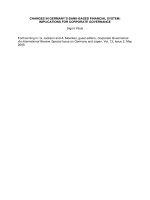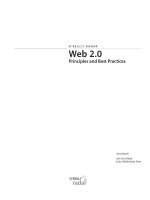Techniques and best practices for corporate governance
Bạn đang xem bản rút gọn của tài liệu. Xem và tải ngay bản đầy đủ của tài liệu tại đây (2.47 MB, 333 trang )
Sarbanes-Oxley
and the Board
of Directors
Techniques and Best Practices for
Corporate Governance
SCOTT GREEN
John Wiley & Sons, Inc.
Sarbanes-Oxley
and the Board
of Directors
Sarbanes-Oxley
and the Board
of Directors
Techniques and Best Practices for
Corporate Governance
SCOTT GREEN
John Wiley & Sons, Inc.
This book is printed on acid-free paper.
Copyright © 2005 by Scott Green. All rights reserved.
Published by John Wiley & Sons, Inc., Hoboken, New Jersey.
Published simultaneously in Canada.
No part of this publication may be reproduced, stored in a retrieval system, or transmitted in any form or by any means, electronic, mechanical, photocopying, recording, scanning, or otherwise, except as permitted under Section 107 or 108 of the 1976 United
States Copyright Act, without either the prior written permission of the Publisher, or
authorization through payment of the appropriate per-copy fee to the Copyright
Clearance Center, Inc., 222 Rosewood Drive, Danvers, MA 01923, 978-750-8400, fax
978-646-8600, or on the web at www.copyright.com. Requests to the Publisher for permission should be addressed to the Permissions Department, John Wiley & Sons, Inc.,
111 River Street, Hoboken, NJ 07030, 201-748-6011, fax 201-748-6008, or online at
/>Limit of Liability/Disclaimer of Warranty: While the publisher and author have used their
best efforts in preparing this book, they make no representations or warranties with
respect to the accuracy or completeness of the contents of this book and specifically disclaim any implied warranties of merchantability or fitness for a particular purpose. No
warranty may be created or extended by sales representatives or written sales materials.
The advice and strategies contained herein may not be suitable for your situation. You
should consult with a professional where appropriate. Neither the publisher nor author
shall be liable for any loss of profit or any other commercial damages, including but not
limited to special, incidental, consequential, or other damages.
For general information on our other products and services, or technical support, please
contact our Customer Care Department within the United States at 800-762-2974, outside the United States at 317-572-3993 or fax 317-572-4002.
Wiley also publishes its books in a variety of electronic formats. Some content that
appears in print may not be available in electronic books.
For more information about Wiley products, visit our Web site at .
Library of Congress Cataloging-in-Publication Data:
Green, Scott, 1962Sarbanes-Oxley and the board of directors: techniques and best practices for
corporate governance / Scott Green.
p. cm.
Includes index.
ISBN-13 978-0-471-73608-0 (cloth)
ISBN-10 0-471-73608-2 (cloth)
1. Boards of directors—United States. 2. Corporate governance—United States.
3. Corporations—Accounting—Law and legislation—United States. I. Title.
HD2745.G74 2005
658.4'22—dc22
2005010214
Printed in the United States of America
10 9 8 7 6 5 4 3 2 1
In memory of my grandfather who instilled in me the
notion that we owe it to the next generation to leave the
world better than when we entered it. I also dedicate this
book to Nicholas and Christina, who sustain me and
represent that bright and better future.
Contents
PREFACE
ACKNOWLEDGMENTS
xi
xv
CHAPTER 1
A Sturdy Framework
1
GOVERNANCE FACTOR I
Building a Strong Foundation
9
CHAPTER 2
Making of a Governance Revolution
Regulatory Development in the United States
Relative Maturity of Worldwide Governance
CHAPTER 3
Board Basics
Independence Is the Key
Board Size Matters
Committees: Source of Functional Support
The Imperial CEO
Director Development
CHAPTER 4
Dealing with Your Liability Up Front
Business Judgment “Bunker”
Next Line of Defense: Indemnity and Insurance
Reputation: A Priceless Asset
11
12
16
27
28
31
32
36
40
45
45
48
48
vii
viii
Contents
GOVERNANCE FACTOR II
Organize to Lead
53
CHAPTER 5
Minding the Numbers: The Audit Committee
55
A Strong Constitution: The Audit Committee Charter
Your Financial Experts
Listen to the Whiners
Managing the Auditors
Red Flags of Financial Reporting
Internal Control: Six Smart Precertification Steps
CHAPTER 6
How Much Is Fair?: The Compensation Committee
Designing the Plan
Unspoken Cost: Stock Options
Piecework: Transaction Compensation
Danger of Oversized Parachutes
Measuring Performance
Unwanted Incentives
Tell Us about Your Shareholder Equity Plan
The Fight Is On!
CHAPTER 7
Keeping It Clean: The Corporate Governance/Nominating Committee
Governing the Board
Setting the Rules
Evaluating the Board
And the Directors
And the CEO
Next! Succession Planning
Finding That Perfect Director
Is the Strategy Still Valid?
CHAPTER 8
Other Committees to Have and to Avoid
Where Have All of the Executive Committees Gone?
Reemergence of Finance Committees
When Public Policy, Safety, and Research Are Drivers
Addressing Special Occasions
56
57
59
60
66
72
81
82
89
90
91
92
94
95
96
99
100
101
103
107
108
117
120
124
129
129
130
132
133
Contents
ix
GOVERNANCE FACTOR III
Insist on High Standards
137
CHAPTER 9
Hard Work of Building Corporate Values
139
What We Stand For: Statement of Corporate Values
Establishing Behavioral Boundaries
Reporting Bad Behaviors
Rewarding the Good
Learning to Communicate Openly
CHAPTER 10
Healthy Board Dynamics
Deciding Who We Are and How We Will Operate
Coveted Culture
Wanting to Be Engaged
Informed and Proud of It
In the Spirit of Independence
Talking Frankly: Executive Sessions
Balance the Board
Insist on the Best and the Brightest
Final Decision
142
147
148
150
151
156
157
158
162
164
169
170
171
172
173
GOVERNANCE FACTOR IV
Let Them Know You Are Watching
177
CHAPTER 11
Art of Oversight
179
Business Perspective: Monitoring Operations
Risk Perspective: Monitoring Threats and Dangers
Compliance Perspective: Monitoring Management
CHAPTER 12
Hostile Activities
Repelling Sharks
Staggering Boards
Ingesting Poison Pills
Voting Confidentially
Antishareholder Provisions
179
183
192
200
200
202
203
203
204
x
Contents
GOVERNANCE FACTOR V
Communicating Clearly
209
CHAPTER 13
Speaking to the Crowd
211
Importance of Managing Integrity
Disclosing Operating Weakness
Responding to Regulatory Scrutiny
Shareholder Activists: The Emerging Marker
What Not to Do
Damage Control
CHAPTER 14
Required Communications
Perfecting Event Reporting
Other New Reporting Requirements
211
212
213
216
218
219
227
227
238
OTHER USEFUL ADVICE AND CONCLUSIONS
249
CHAPTER 15
Big Money, Little Money, No Money
251
The Moneymakers
Not-for-Profit Boards
Serving on Advisory Boards
A Word about Small Public Companies
251
263
269
271
CHAPTER 16
A Call to Service
277
APPENDIX A GMI Corporate Governance Ratings
283
APPENDIX B General Motors Corporation: Audit Committee of the Board
of Directors Charter
287
APPENDIX C Board Evaluation Tool: NACD Sample Board Self-Assessment Questionnaire
293
APPENDIX D Champion Enterprises, Inc. CEO Evaluation
297
APPENDIX E Statement of Values: Johnson & Johnson Credo
301
APPENDIX F TIAA-CREF Principles for Fund Governance and Practices
303
INDEX
308
Preface
Nearly three years ago, as the Sarbanes-Oxley Act became law, I recognized that there would be a need for accessible but detailed guidance
to help managers implement certain sections of the Act. Additionally, it
was clear that related social systems must also be addressed if the time
and money spent on internal controls was to be effective. These beliefs
motivated me to write Manager’s Guide to the Sarbanes-Oxley Act
(John Wiley & Sons, 2004) for medium and small public companies as
an aid to compliance. (The guide has since then found an audience in
large organizations as well.) The procedural aspects of Sarbanes-Oxley
have indeed been burdensome, particularly on smaller companies. As I
sat down to write Manager’s Guide, I was tempted to expand the scope
of the book to include other audiences. After its publication, my focus
on the needs of our nation’s corporate managers was validated by the
book’s acceptance in the marketplace. Nevertheless, other stakeholders
were still left without a text that enables quick, easy assimilation of the
important compliance criteria emanating from Sarbanes-Oxley. One
such group encompasses the thousands of directors who sit on the
boards of every corporation and those who support their activities.
I was constantly reminded of this need. At conferences at which I
was invited to participate—and radio, television, and online “webinar” appearances relating to Manager’s Guide to the Sarbanes-Oxley
Act—questions frequently moved beyond purely management concerns to the broader role of the Act and governance in the U.S. business model. Over time, I have tried to address many of these
questions through my academic and professional writings.* These
*These include “The Limitations of the Sarbanes-Oxley Act,” USA Today
Magazine, (March 2005); “Abolish the Imperial CEO,” Journal of Corporate
Accounting and Finance (September 2004); “The Ripple Effect,” Internal Auditor
Magazine (February 2005); “The Causes, Impact and Future of the Sarbanes-Oxley
Act,” Journal of International Business and Law (Spring 2004); and “Take Seven
Key Actions Before You Certify,” Journal of Corporate Accounting and Finance
(May 2004).
xi
xii
Preface
articles dispensed useful advice to the nation’s directors and gatekeepers. However, each by nature is narrowly focused and cannot
independently quench the incredible thirst for knowledge on the subject. Therefore, I have written a book in which much of this advice
has been excerpted and included together with the other important
issues of our day.
There is little doubt that the risks from sitting on a board, including not-for-profits, has risen exponentially, leaving directors and
related stakeholders searching for answers. This necessitates a clearly
written book that helps new or potential directors understand how
boards operate, detail the special risks of board committees, identify
best practices, and recognize the red flags of board governance. Such
a book is also useful to sitting directors for understanding governance trends, evaluating their own practices, and understanding
what needs to be done if things go wrong. This type of analysis helps
directors to properly represent the company’s shareholders and limit
their own liability.
The problem with many books on corporate governance is that
they are narrowly focused, addressing a segment of governance such
as director liability, board independence, culture, risk assessment,
and so on, or are written at a highly theoretical level that lacks practical guidance on application. I have set out to provide a book that
assists potential, new, and sitting directors in understanding and
meeting the word and spirit of the Sarbanes-Oxley Act and beyond.
This is accomplished not only by citing the requirements of the
Sarbanes-Oxley Act, but also by exploring best practices found
around the world. These practices are then packaged into five discrete governance factors to help directors think about governance as
a process, one that can be followed, the results analyzed, and the
implications of conclusions determined. Numerous real world examples, vignettes, case studies, surveys, and other data are presented to
bring context to the discussion.
My beliefs regarding board operations is similar to the one that I
hold for company management—that is, simply implementing procedural rules will not be effective if social issues are ignored. The
boards of Enron and WorldCom met the checklist criteria for acceptable governance practices of their day, and yet the companies melted
down on their watch. The culture of the company and social interaction of the board make a difference, and a workable framework
Preface
xiii
weaves this important concept into the new procedural changes
required by legislation, regulators, and even best practice.
Once you have completed this book, you will:
■
■
■
■
■
■
■
Understand how current governance practices developed
Appreciate your potential liability as a director
Recognize the red flags of governance
Be conversant in issues surrounding director selection and evaluation
Understand the strengths and weaknesses of certain board structures
Grasp the additional responsibilities associated with committee
assignments
Know what steps to take when a potential crisis threatens the
company
You will also have the tools to implement best governance practices even when there are few serious threats to the company. The
complexity of a directorship requires supervisory ability, emotional
intelligence, and attention to procedural details. These skills are
important not only for the health of the company and its stockholders. They also protect a director’s reputation and financial wellbeing. Risks to a serving director are real and must be managed.
Those who sit idle as events unfold around them will be held
accountable. The best way to protect yourself is to be aware of the
risks, remain engaged, and actively work for the stockholders of the
company.
Acknowledgments
This book is truly a collaborative effort. Without the help of many, it
is likely that the topics raised in this book would be impenetrable to
all but the most dogged readers. These topics are usually technical;
nevertheless, the goal here is to present them in a highly accessible
manner. (The initial drafts could quite possibly be classified as torture
under international law!) To that purpose, several individuals dedicated substantial time reading my work-in-progress and challenging
and helping me to refine the text so that we could benefit from their
knowledge and expertise. They include Mark Chimsky, Harold
Gibson, Jim Balsillie, Rich Davis, Dr. Cliff Green, Dane Bonn, Scott
Foushee, Susan Foushee, Allan Shaw, Julie Daum, Arnold Ross, Mike
Wilson, Les Zuke, Kevin Curtin, Lori Leach, and Gabriella Green.
While the opinions contained herein are my own, and not necessarily those of Weil, Gotshal & Manges, I would nevertheless like to
express gratitude to those colleagues and coworkers who support my
writing activities. Without their help, my books would remain
unpublished. They include Stephen Dannhauser, Norman LaCroix,
and Robert Messenio.
I would like to thank Sheck Cho, my editor, who believed me
when I preached that Section 404 of the Sarbanes-Oxley Act would
result in the need for literary support. He has helped John Wiley &
Sons, Inc., dominate the fulfillment of that need. He has also thrown
his considerable support behind the needs of our nation’s boards of
directors faced, as they are, with the ever-changing world of corporate governance. Sheck and the entire Wiley team are first rate. I also
appreciate the efforts of my agent, Richard Curtis. His advice is
always “top shelf.”
A special thanks to the fine companies that have contributed
their years of collective knowledge and experience to this book is also
due. Johnson & Johnson’s Credo, General Motors Audit Committee
Charter, TIAA-CREF’s Principles for Fund Governance and Practice,
National Association of Corporate Directors Board Evaluation Tool,
xv
xvi
Acknowledgments
and Champion Enterprises, Inc.’s CEO Evaluation Form are all
examples of best practice. I also thank General Metrics International
for sharing their corporate governance ratings, Spencer Stuart for
contributing key findings from their annual board survey, and
AuditAnalytics.com for their research on U.S. accounting firms. We
can now all benefit from their research, hard work, and effort perfecting these documents and related standards.
Sarbanes-Oxley
and the Board
of Directors
CHAPTER
1
A Sturdy Framework
ou have worked hard your entire career, reached the pinnacle of
your profession, obtained the respect of your peers and community, assured yourself financial success, and are recognized as an outstanding alumni by your alma mater. Then you get a call to take on a
new job that is time consuming, will test your character, and can
destroy your reputation and wealth. As unappealing as that sounds,
it happens every day and many do not hesitate to answer the call.
The offer of sitting on the board of directors for a public company is often viewed as the culmination of a successful career. The
self-esteem, social recognition, and business networking opportunities might be all that come to mind when such an offer is made. Smart
executives will also carefully consider the risks. They assess the
health of both the business and the board. They evaluate whether
they can truly contribute as a director. They recognize that if they
accept, the job will require homework to make certain that they are
prepared to perform their duties according to the highest principles
and implement practices that will protect their reputation and ensure
their professional survival.
The problem, however, is that newly appointed directors typically have not prepared themselves for this role. As successful executives, many believe that they have all the requisite tools and
knowledge necessary (and could likely teach others a thing or two).
In reality, a directorship is a job that takes preparation, requires a
thorough understanding of governance practices and responsibilities, and requires a different mindset than that of management.
Directors are representing stockholders and, as such, must possess a
certain amount of professional skepticism in executing their duties.
Failure to do so is a breach of the most sacred business covenants:
duty of care, good faith, and independence. The purpose of this
chapter is to introduce a framework that will enable directors to
Y
1
2
CHAPTER 1
approach their job in a way that minimizes their risk and maximizes
their impact.
There are certain board facts that all potential directors should
grasp, namely, that being a director is:
■
■
■
Time consuming. Most boards in the S&P 500 hold just under
eight meetings per year on average.1 Some board committees
meet frequently. Audit committees not only meet more frequently than other committees, they also carry more responsibility.
Risky. If the company comes under attack for illegal or even
unethical behavior, a director’s reputation could be forever tarnished. If related decisions are deemed to lack good faith, they
can be financially damaging as well.
Not as profitable as you might think. While compensation at
larger companies can be significant (and is increasing to attract
reluctant candidates), the amounts usually pale in comparison
to the individual’s net worth. For smaller company directors,
their net worth may not be comparable, but neither is the compensation.
Nevertheless, there are benefits to becoming a director. Most of
these are quite obvious. There is the respect and other psychic
rewards associated with being selected to serve a company. An invitation to be a director is often viewed by many as reaching the pinnacle of the business world—your acceptance to the “club.” A
directorship can result in business and social networking contacts
not otherwise available. Many directors enjoy the mentor role
involved in helping to guide a company to greater prosperity. This
is not to suggest that these rewards are not worth the liability associated with becoming a director. In fact, there are legitimate concerns that many qualified candidates conclude outweigh the
rewards. It is suggested that potential directors need to do their
homework to make certain that they are joining a healthy board
that supports transparency and acts in the best interests of stockholders.
It is critical for the health of our public companies that quality
directors continue to provide them with the benefit of their experience.
A Sturdy Framework
EXHIBIT 1.1
3
High-Impact Governance Framework
As such, directors not only need information, but a framework that
will help guide and provide confidence that they are doing all that
they can to reduce their personal risk by championing rock-solid governance practices. The High-Impact Governance Framework is such
a device designed with a view toward providing the power tools that
conscientious directors seek. The framework contains the strongest
concepts currently available and is unapologetically black-belt grade
with the director’s well-being at heart. It consists of five governance
factors: Build a Strong Foundation, Organize to Lead, Insist on High
Standards, Let Them Know You Are Watching, and Communicate
Clearly (see Exhibit 1.1).
GOVERNANCE FACTOR I: BUILD
A STRONG FOUNDATION
We begin our journey by placing our initial focus on building a
strong governance foundation. This includes a brief legislative history to put current events into proper context. Having the right
board structure can be important to good process, so “board basics”
will be introduced to serve as the bedrock for the governance structure. In this section, we also cover director “independence,” “good
faith,” and the “business judgment rule” as it relates to director liability and ways a board can mitigate risk.
4
CHAPTER 1
GOVERNANCE FACTOR II: ORGANIZE TO LEAD
Once our foundation is established, Factor II will help us organize
to lead. A board can lead without proper organization, but it only
makes the job more difficult. We will evaluate the role of the audit
committee and explain why an intelligent director candidate should
interview the CFO and the outside auditor among others before
taking on such a responsibility. Even if you do not intend to sit on
the audit committee or consider yourself a financial expert, this is a
critical step. It is important to form an opinion regarding the
aggressiveness of management’s financial policies. A high-level discussion regarding the company’s revenue recognition, reserve, and
financing policies can tell a director much about management’s
approach to business. Motivated candidates should also interview
the general counsel regarding any pending legal or regulatory
issues. For instance, you do not want to learn at your first board
meeting that the company’s sole product is being contested for violating a patent. We will explore a number of red flags that directors
can familiarize themselves with prior to interviewing the external
auditor and general counsel.
There has been no shortage of compensation scandals. Directors
are coming under increasing fire for their lack of oversight and
understanding of the compensation plans covering their executives.
Given the amount of recent litigation and negative press, a potential
director should always attempt to determine if there are any compensation issues forming. We will examine both faulty remuneration
plans and the components of a strong plan.
Most director nominees understand how they were selected for
board service. Nevertheless, we will study components of a strong
nomination process and the risks of directors selected through the
good old boy network. One of the country’s best corporate matchmakers will share her experiences and an action plan that helps
boards identify that perfect candidate. We will examine when committees, other than audit, compensation, and governance, might be
appropriate and highlight one committee to be avoided.
A Sturdy Framework
5
GOVERNANCE FACTOR III: INSIST
ON HIGH STANDARDS
A board can follow all the right rules, check all of the governance
boxes, and still preside over a rapid financial meltdown of stunning
proportions. This happens because a premium is placed on process
over culture and social systems. The path to high-impact governance
requires that the board insist on high social standards. This includes
establishing the right culture, not just in the company, but also in the
boardroom. Building a strong culture is more than issuing a statement of values or code of ethics; it is the result of a prolonged program of communication and action that clearly delineates behavioral
boundaries and rewards desired activities. This “soft subject” is worthy of even the most hard-nosed boards. A strong, ethical culture can
overcome a number of governance sins, and directors have a vested
interest in supporting steps to embed such a culture in order to keep
their personal liability to a minimum. Together, we will explore the
social characteristics of boards that work well together and how they
are able to set and enforce the proper “tone from the top.” Finally,
we will evaluate desired board behaviors and ways to reinforce them,
some structural, some not. This includes conducting executive sessions without unnecessarily upsetting the CEO and the importance of
populating a balanced board with the people you need to succeed.
We will further examine what qualities effective directors and their
boards possess (and why a nominee should also determine who else
is on the board), their background, their ownership stake in the company, and the board’s relationship to management to determine if it
is sufficiently independent to ensure healthy debate and decision
making.
GOVERNANCE FACTOR IV: LET THEM
KNOW THAT YOU ARE WATCHING
Even a well-organized and socially healthy board can falter if it does
not possess strong oversight skills. Techniques for board supervision
and monitoring will be reviewed in this part of the book. We will
address risk analysis, operational oversight, and even monitoring
management’s compliance with corporate policies. We will also cover

